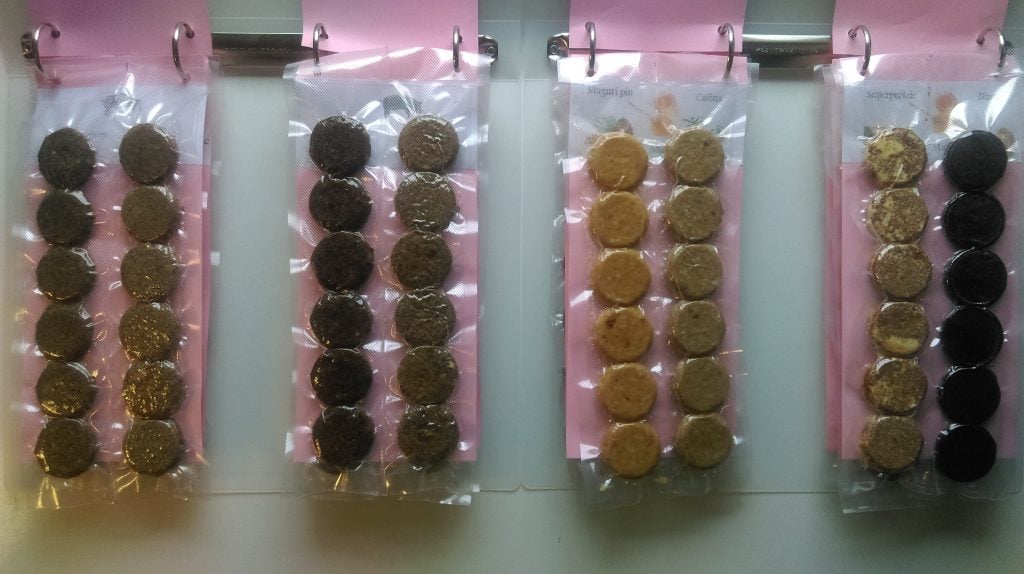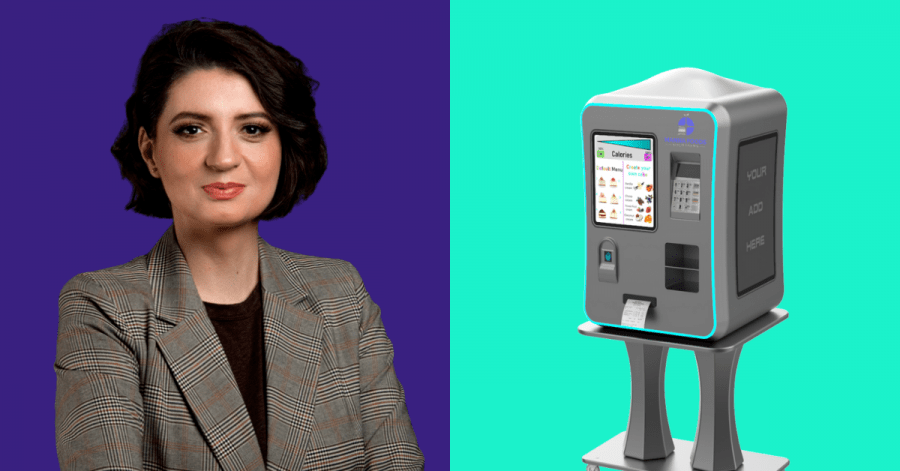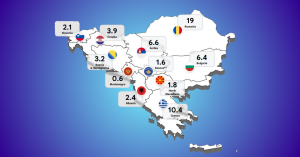It is no news that the food industry must explore new ways of feeding the increasing needs of our global society. To do so in an economical, nutritional, and effective way truly requires an innovative approach. How about nutritional cooked food tablets and 3D food printing vending machines that can make sandwiches in two minutes?
The Recursive talked to Madalina Ilie, novel foods enthusiast and founder of Manna Foods Solutions, a food tech startup from Bucharest, Romania who aims to revolutionize the industry. After working in communications and sales, Madalina is at her first entrepreneurial endeavor, yet she always knew she wanted to make a difference in the food industry.
Under the motto “visionary foods, changing the world”, the company is developing products that can be applied globally and serve different customer segments.
For instance, their ready-to-eat food ODA tablets are designed to replace meals effectively, with almost no water but all necessary nutrients, as applied to the case: vulnerable groups in relief areas, military groups, and space missions. Tablets can be adapted to age, occupation, health conditions, and dietary requirements. This is the first time the company shares more insights about the development of the ODA tablets and the business model behind them.
The Recursive: How did you come up with the idea of launching Manna Food Solutions?
Madalina Ilie: In 2018, we started with just two people, with the intention to dry bee honey, to make tablets as sweeteners for tea and coffee. No one actually dries honey in a natural way, keeping its structure compact. We managed to develop the technology that achieves this.
Then, we started to use the same technology for other ingredients, like meat, vegetables, fruits, and oleaginous (fruits with high content of oils). After experimenting, we managed to make cooked food in the form of food tablets. Those were the first steps into creating the ODA (Optimum Dynamic Activities) tablets.
One year later, one of our colleagues started a course in 3D printing. Soon enough, he started researching applications in the food area. We saw an opportunity in developing our own 3D food printers, designed as vending machines, which translate into our second project, Reebo.
It started not only with experimenting in the sector but also with my passion for food. Since I was just a little girl, I was very attracted to this area. At some point, I thought to myself that one day in my life I will do something that will amaze the world. I wanted to bring something very novel and with an international application. And here we are today.
Given that the global population is rising, and we will need more food and more agricultural land, how will these innovations help fit the needs of future generations?
At the core of our business, the innovations we develop must have a social impact component. This is because today we are facing some critical challenges. The global population is growing at a fast pace, demanding more food, yet climate change effects are more and more extreme, with grave consequences for the agricultural sector.
Actors in this industry need to develop solutions that better fit tomorrow’s society. Both ODA and Reebo have components with social impact. The Reebo food machines can be placed in areas affected by poverty, malnutrition, or natural disasters as an accessible food source. Food is not a desire, it’s a necessity. And because we have these technological instruments today, we can develop solutions that can feed the world.
The ODA tablets are compressed cooked food. Imagine a plate with steak and potatoes. Well, all this can be put in a tablet. We can make the tablets into special humanitarian food aid kits, toolboxes, for people in vulnerable groups across the world.
Compacting food helps save time in bringing these aid kits in cases such as humanitarian emergencies, as well as save water resources. It takes less time to send food tablets because they occupy a much lower space. One 1.5 liter bag fits 100 tablets, which can end up feeding one person for approximately 14 days. It also helps save water as compared to food powders, which are currently sent. Water is equally precious and hard to get in many countries.
Our goal is that the ODA solution becomes a state reserve in the countries that need it. Easy to take and send in response to a crisis.
Tell us a bit more about the innovations behind the ODA tablets.
The tablets represent ready-to-eat, cooked food. They are nutritionally controlled and can be personalized for different situations. They are also even better at taste than traditional food.
Once opened they can be consumed in five days, otherwise they have a five years shelf life. That is because the main technological process behind is the elimination of water from food, with water being the main component that develops bacteria.
When we will establish the production line and the setup of the menus, the tablets will also come with the daily needed dosage of vitamins and minerals. Eating these food tablets ensures an already diversified diet, which means you no longer have to take vitamins or minerals. And they will be made only with natural ingredients, no added preservatives, artificial flavors, etc.
We are now in the experimental prototype phase, TRL 3 (Ed.note on the scale of 1 to 9).

How does Reebo, the 3D food printing vending machine work?
When we started Reebo, we wanted to bring some new features to the 3D food printing process. It’s designed as a vending machine, so it’s bigger than any other 3D food printer on the market today. There is enough space inside the machine to put larger cartridges – up to 8 kilograms, compared to 200-300 milliliters capacity for traditional ones.
Also, Reebo can currently make sandwiches or cakes in just about 2 minutes, compared to 20 minutes or to an hour, which is how long it takes other 3D food printers. Importantly, the sandwiches and cakes are ready to eat. Most other 3D food printers offer food that still needs to be cooked. We further want to offer our business clients access to consumables. So, we would not provide the equipment alone, but also the food paste input.
Reebo is currently in an incubator phase. We are in phase two of the EIC accelerator program.
How have you been funding the R&D work and the overall business and what are the prospects for the future?
So far, we made the research based on our resources and managed to make 3D cakes and sandwiches. But there can be so many other applications. In order to test more ingredients and make other food products we need R&D, and therefore money.
Multinational companies are on this trend where they are looking for innovations, but they really don’t want to get involved in R&D too much. They are trying to innovate with products that they already have on the market, rather than invest in new product innovations. It’s a bit difficult to do R&D in Romania due to the fact that we do not have an infrastructure for this. All the big food companies in Romania don’t have R&D centers here.
If you don’t have funds to develop projects here, then you will be outrun in the market by startups in countries where funding is available. We are living in a world of technology and the future belongs to technology. And there are countries like the US, Canada, the UK, China, with large amounts of money for R&D in different industries – and they are moving fast.
If you are in Romania, you experience this huge bottleneck of not having access to funds. You cannot make physical products in order to present them to potential investors for the next phase. And this is the main problem. You may have a chance with revolutionary innovation. You will definitely have a big opportunity with digital technology. But with physical products, it’s another discussion.
What are the other consumer segments you are targeting? What prices should we expect to see?
As mentioned, we will be serving vulnerable people, going through humanitarian crises. We will also be serving the military. Here, we aim to have governments as the main customers.
Aside from that, we want to create menus dedicated to people who have different health issues that require a controlled diet, as well as people who just do not have enough time to cook. We see that increasingly we don’t have time to cook and this is a problem for the body. The tablets are aimed to be friendly with our times and our nutritional requirements.
When it comes to pricing, it is difficult to be set in stone today. We aim to launch in two years’ time. There are also certain parameters to be taken into consideration – prices will depend on the mixtures inside the tablets and the purpose they will serve.
But there are some average prices that we can work with today. We aim to set the average price per tablet at one euro. Tablets will not be sold individually, we will create menus and kits, depending on the customer segment.
What advice would you give entrepreneurs at the beginning of their journey?
Entrepreneurs must have perseverance. When you build a solution, no matter the industry, you face so many challenges, and at some point, you are overwhelmed by all the challenges. You have those moments when you say “that’s enough, I’m tired, I just can’t do it anymore”. And that is the precise moment when you have to recalibrate yourself. If you really believe in your solutions, in your projects, and in your company, then you must go forward despite these temporary setbacks.
On the other hand, it’s very satisfactory, because even though you see results over long periods, you know how much work and sacrifices you have made in order for those projects to come alive. It’s not about the money in the beginning, because you don’t have so much money as a startup.
And you must have courage, of course, but also fear. A few days ago I read a statement saying “it’s okay to have fear because then it means that you are doing something really big and important”.
For some people, including me at times, it is a source of encouragement, a motivational factor to go on. I’m having a real conversation with my fear – “I see you, I feel you, now go away, I have a business to do”. It’s important to be able to stare in the mirror and talk to your fear.








